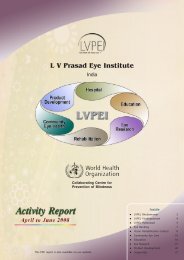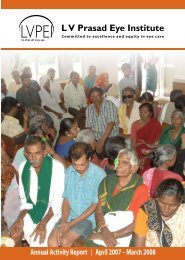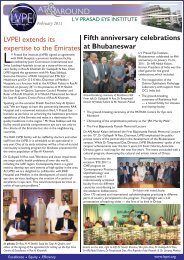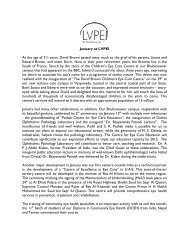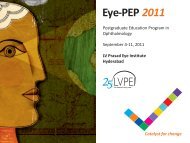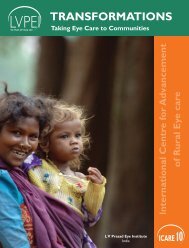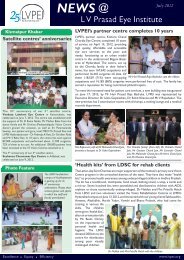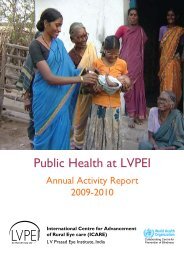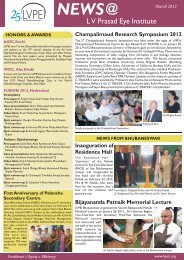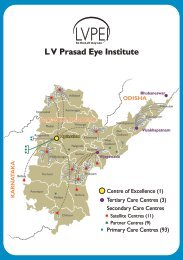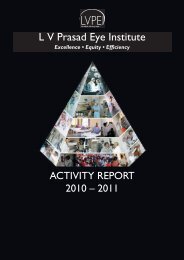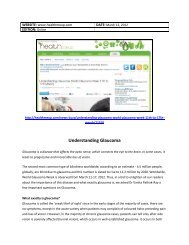IERG Abstracrt Book.indd - LV Prasad Eye Institute
IERG Abstracrt Book.indd - LV Prasad Eye Institute
IERG Abstracrt Book.indd - LV Prasad Eye Institute
You also want an ePaper? Increase the reach of your titles
YUMPU automatically turns print PDFs into web optimized ePapers that Google loves.
34 Oral Presentationyears. In four cases, penetrating keratoplasty (PKP) was performed at 3-4 months.Results: A distinct population of small cells expressing high levels of p63 with greater N/Cratio was identified in BME. These cells were confirmed as SCs since they were negative forCx43, positive for melanoma-associated chondroitin sulfate proteoglycan and showed theability to form holoclones with the colony forming efficiency of 0.2%. There was a fourfoldincrease in total number of SCs in cultured epithelium. After transplantation, anatomical andvisual improvement was observed in 4/10 LSCD patients including two who underwent PKPpostoperatively. The epithelial cells in excised corneal buttons were positive for K5 but stillnegative for K12, indicating the presence of original transplanted BME.Conclusions: The two parameter analysis is a specific method to identify and quantify buccalepithelial SCs. Transplantation of such bio-engineered SC rich autologous BME, followed byPKP is a strategy for reconstruction of the corneal surface in bilateral LSCD.IPT 008Evaluation of Human y 79 Cell Lines for Putative Stem Cell Properties by SingleCell Assay and Gene ExpressionMurali MS Balla, 1 Geeta K Vemuganti, 1 Chitra Kannabiran, 2 Santosh G Honavar, 3Ramesh Murthy 31Sudhakar and Sreekanth Ravi Stem Cell Biology Laboratory, 2 Kallam Anji Reddy MolecularGenetics Laboratory, 3 Ocular Oncology Division, L V <strong>Prasad</strong> <strong>Eye</strong> <strong>Institute</strong>, Hyderabad, IndiaPurpose: Cells from tumors like retinoblastoma are suspected to have two kinds of cellpopulations, one being quiescent stem like cells, and other dividing cells. In order to investigateand quantify the populations, we studied the human Rb cell line Y79 for their clone formingability, differential gene expression and cell cycle status.Methods: Y79 cell line was maintained in RPMI with 10% FCS. Single cell assay was performedto evaluate clone-forming ability. Cells were analyzed for CD133 by Flow cytometry andsorted for CD133+/CD133- populations. These two subpopulations were then evaluated forcell cycle status by propidium iodide labeling, and differential expression of putative stem/progenitor cell markers ABCG2, PROX1 by RT-PCR.Results: Clone forming ability was noted in 26.6±3.8% cells and CD133 expression in 79.7±1.3%of the cells. RT-PCR analysis of the CD133- population showed the expression of PROX1,which was not detected in the CD133+ cells. Majority of CD133- population (83.3±4.1%)were in G0/G1 phase as assessed by PI staining, while CD 133+ cells were predominantly(81.1±10.6%) in S, G2/M phase.Conclusions: The Y79 cell line showed presence of cells with clone- forming ability anddifferential expression of CD133, thus supporting the existence of putative stem-like cells.Expression of PROX1 and quiescence of CD133- cells, further substantiate this hypothesis.



